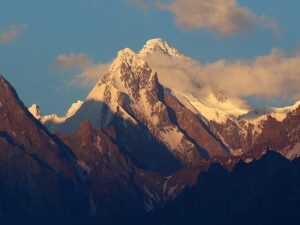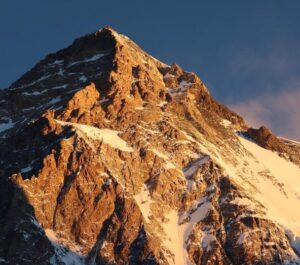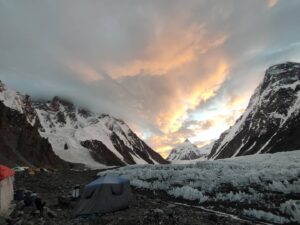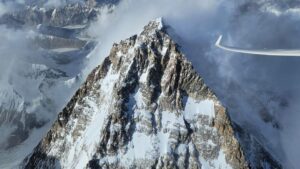The Second Seven Summits, the lesser-known and more difficult little brother of the Seven Summits, involves climbing the second-highest peak on each continent. In Asia, this means the gargantuan 8,611m K2.
Many names
K2 is a mountain of many names: Chogori, Qogir, Ketu, BK22, Chabrun, Lamba Pahar, Chiring, Dapsang, Deosai, Mustakh, Skinmag, and the Savage Mountain.
K2 straddles China and the Gilgit-Baltistan region of Pakistan. This second-highest peak on earth lies in the northwestern Karakoram Range and is part of the sub-mountain range of Baltoro Mustagh, which is to the north and east of the Baltoro Glacier in Baltistan.

The Baltoro Glacier from the air, looking east. Photo: Wikipedia
The Baltoro is one of the largest glaciers in the Karakoram. The name “Baltoro” is probably of Tibetan origin, meaning “offering fertility.” That fertility comes in the form of water that flows out from the glacier. The word “Mustagh” means “icy, snowy mountains”. The Baltoro Mustagh has proven fertile for climbers too. Four 8,000m peaks rise here: K2, Broad Peak, Gasherbrum I, and Gasherbrum II.

Mountaineers trek in front of the southern slopes of K2. Photo: Sebastian Alvaro
Early history
In the summer of 1838, Scottish geologist, botanist, and paleontologist Hugh Falconer arrived in the region. With the support of Rajah Ahmud Shah, he traced the Shigar branch of the Indus to its source at the glacier on the southern flank of the Mustagh range. The local mountain people sometimes visited the lower parts of the Baltoro Valley, moving with their sheep to fresh grazing areas, but Falconer was probably the first foreigner to reach the Baltoro Glacier.

The southwestern slopes of K2. Photo: Sebastian Alvaro
In the summer of 1856, German explorer Adolf von Schlagintweit also scouted the Baltoro region, including the old Mustagh Pass. In the same year, a group called the Topographical Survey of India Party, led by British surveyor Thomas George Montgomerie, located a series of towering peaks in the heart of Karakoram. Montgomerie labeled each summit simply: “K” (for Karakoram) followed by a number (K1, K2, K3, etc). The second summit that they triangulated became K2.

Glacier river at the confluence of the Baltoro Glacier and Godwin Austen Glacier. Photo: Jetsetwunderlust
British surveyor Henry Haversham Godwin Austen also took part in the topographical project. A few years later, in 1886, he returned and came close to K2. He authored the first synoptic map (summarizing atmospheric conditions) of the area and described how to access K2.
Inching closer
In 1887, British explorer Francis Edward Younghusband traveled the Karakoram chain, crossing the old Mustagh Pass from north to south. He was the first foreigner to observe K2 from the north. Three years later, Italian explorer Roberto Lerco reached the lowest slopes of K2, and the British politician and mountaineer William Martin Conway made an exploratory trip to K2 in 1892.

K2’s Southwest Face. Photo: Sebastian Alvaro
Climbing K2
The first party to attempt to climb K2 was a British-Austrian expedition in 1902. Led by Oscar Eckenstein, and including the wacky occultist and all-around bad boy Aleister Crowley, the group tried to ascend the northeast ridge but only made it to 6,000m.

The always theatrical Aleister Crowley gives his best evil eye stare during the 1902 K2 expedition.
A second attempt came in 1909. An Italian expedition, led by the eminent alpinist and explorer Luigi Amadeo di Savoia, Duke of the Abruzzi, located what looked to be the best route to the summit. Following the southeast spur, it became known as the Abruzzi Spur, or Abruzzi route. But the team also aborted at around 6,000m.

K2 in 1909. Photo: Vittorio Sella
The Duke’s route has become the most frequently climbed line on the mountain, and more than 40 years later it would see the first successful ascent.
But before K2 was finally climbed in 1954, there were three more notable failed attempts.
The 1938 Houston expedition
In 1938, an American expedition led by Charles Houston tried to find a reliable climbing route on the mountain and make a detailed reconnaissance. Nobody expected them to summit, but they did make a serious attempt without supplemental oxygen.
The team included some of the best climbers in America. One of the team members, 24-year-old William House, was the first to climb a vertical section of difficult rock located at 6,600m on the Abruzzi Route. This section, now called House’s Chimney, connects Lower Camp 2 (6,570m) and Upper Camp 2 (6,700m).

Adam Bielecki climbs House’s Chimney during a winter K2 expedition in February 2018. Photo: Denis Urubko
The Americans installed seven high-altitude camps as they ascended. On July 21, climbers Paul Petzoldt and Charles Houston reached a shoulder on the crest at 7,800m. Together they proceeded 100m higher. From there, Petzoldt pushed up another 25m alone, halting at 7,925m.
The expedition was considered a success. Nobody had reached almost 8,000m before.

The Abruzzi route on K2. Photo: Team Ali Sadpara
The 1939 Wiessner expedition
Fritz Wiessner led the second American expedition to K2. Wiessner was an outstanding German rock climber, with a strong, demanding character. In 1932, aged 32, he joined an expedition to Nanga Parbat with Willi Merkl. Merkl and Wiessner managed to reach 7,010 m. Merkl would die on the same mountain two years later.
In 1939, Wiessner’s American team attempted K2 without bottled oxygen, also along the Abruzzi Route. The team of six Americans and nine Sherpas arrived at Base Camp on May 31.

K2, 1939. Photo: Jack Durrance Collection
After a complicated ascent, Wiessner and Pasang Lama reached 8,385m on July 19. American team member Dudley Wolfe remained up in one of the high camps alone when Wiessner and Pasang Lama descended. Three of the Sherpas who went up to rescue Wolfe never returned. These were the first deaths on K2.
This is one of the most important expeditions in the history of K2. Therefore, we will examine the attempt in greater detail in a future story.

Lino Lacedelli at their high camp, before setting out to climb K2 for the first time. Photo: Achille Compagnoni
The third American attempt in 1953
After the 1939 tragedy, there was no other attempt to climb K2 until 1953. That year, a team led by Charles Houston arrived at Base Camp on June 20. This was a lightweight expedition for the time. On August 1, they put up their eighth camp, at around 7,800m on the Abruzzi Spur. The next day, they planned to start their summit push.
But the weather worsened overnight and they were stuck there for 10 days. To make matters worse, there was a medical emergency too. Art Gilkey developed blood clots in one of his legs and showed signs of a pulmonary embolism. Houston decided that they should all descend.
At 7,500m disaster struck. George Bell slipped and looked like he would drag six climbers into the void. Pete Schoening quickly wrapped the rope around his shoulders and ice ax, arresting the slide just in time. Holding six people, Schoening’s feat became known in mountaineering history simply as The Belay.
Later, Gilkey was likely swept away by an avalanche. Despite the tragic death of Gilkey, and difficult descent, this team was a very united group. The team members have maintained lifelong friendships.

The camps on the Abruzzi Spur and the 1953 expedition’s highest point. The accident happened between Camps 7 and 8. Photo: Wikipedia
The first ascent
K2 was first ascended by Italian climbers Lino Lacedelli and Achille Compagnoni on July 31, 1954, via the Abruzzi Spur. Led by Ardito Desio, the expedition used supplemental oxygen.
The team included Walter Bonatti and the Pakistani porter Hunza Mahdi, whose work moving oxygen cylinders proved vital to the success of the expedition. Mahdi and Bonatti even had to bivouac at 8,100m because of a misunderstanding with Lacedelli and Compagnoni. Their route is the most frequently used one on K2.

The Black Pyramid on K2. Photo: Elia Saikaly
Other routes
Aside from the Abruzzi route, there are nine other routes on K2. Some have only been completed once.
Southwest Ridge 1981
This route, on the West Face of K2, was first climbed in 1981 by a Japanese expedition under the leadership of Teruo Matsuura. It was the fifth ascent of the mountain. Japanese climber Eiho Otani and Pakistani climber Nazir Ahmad Sabir topped out on August 7 that year.
The Japanese expedition used supplemental O2 to open the route.

A climber on the Southwest Ridge of K2. Photo: Sebastian Alvaro
North Ridge 1982
The north ridge was first climbed in 1982 by a Japanese expedition led by Isao Shinkai and Masatsugu Konishi. Between August 14 and 15, seven climbers reached the summit without supplemental oxygen. Naoe Sakashita, Yukihiro Yanagisawa, Hiroshi Yoshino, Kazushige Takami, Haruichi Kawamura, Tatsuji Shigeno, and Hironobu Kamuro thus completed the sixth ascent of K2 via this new route.

The northern slope of K2. Photo: Sebastian Alvaro
South-Southwest Pillar 1986
The route is better known as the Magic Line. It was first climbed by a Polish-Slovak expedition led by Janusz Majer. On August 3, 1986, Wojciech Wroz, Przemyslaw Piasecki, and Peter Bozic summited. A day later, Wroz died during the descent. The climbers went without bottled oxygen.

On the Magic Line in 2004. Photo: Jordi Corominas
South-Southeast Spur (Cesen Route, Basque Route) 1994
A Spanish-Basque expedition led by Juan Oiarzabal climbed this route for the first time in 1994. On June 23, Juan Oiarzabal, Alberto and Felix Inurrategui, Enrique de Pablos, and Juan Tomas reached the summit without supplemental oxygen.
It is sometimes called the Cesen route. In 1986, Slovenian climber Tomo Cesen managed to reach the shoulder of K2 via this route. However, he did not top out. The 1994 expedition managed to complete Cesen’s route to the top, joining the Abruzzi Route on the shoulder and continuing to the summit.

The South-Southeast Spur on K2. The red arrow indicates Camp 2. Photo: Dave Watson
Routes that have not been repeated
Northeast Ridge 1978
An American expedition led by Jim Whittaker first ascended the long Northeast Ridge. The route followed the Northeast Ridge, then the East Face, and then the Abruzzi Ridge. On September 6, 1978, Louis Reichardt and James Wickwire summited. John Roskelley and Rick Ridgeway topped out the next day. This was the third ascent of K2. They summited without bottled oxygen.
There is an interesting historical wrinkle on this ascent. Either Reichardt or Roskelley is the first person to summit K2 without bottled oxygen. Reichardt abandoned his oxygen bottle on the way up because it didn’t work. Roskelley summited after Reichardt but never had O2 with him. The question is whether Reinhardt’s oxygen ever worked at all. It was the third ascent of the mountain and the first ascent without O2. It has never been repeated.

Climbing on the knife-edge Northeast Ridge of K2. Rick Ridgeway is in the foreground, with Louis Reichardt behind, at about 7,010m. Photo: John Roskelley
South Face (Polish Line, Central Rib) 1986
This dangerous line was first climbed on July 8, 1986, by Poles Jerzy Kukuczka and Tadeusz Piotrowski. The route is full of seracs, and Piotrowski suffered a fatal fall during the descent. They did not use supplemental oxygen, and the route has never been repeated.

The southern slope of K2. Photo: Sebastian Alvaro
Northwest Ridge–North Ridge 1991
Frenchmen Pierre Beghin and Christophe Profit followed the Northwest Ridge, then diagonally traversed the Northwest Wall, and finally followed the Japanese North Ridge route of 1982. They reached the summit on August 15, 1991, without supplemental oxygen.
Although they climbed very little new terrain, they climbed the top section of the route in alpine style, without fixed routes or established camps. It is the “cleanest” climb of K2. At first sight, the line is not logical due to a kind of S-shape. No one has ever repeated this difficult and exhausting route.

The Northwest Ridge on K2. Photo: John Shen
West Face 2007
The wild West Face was first ascended by a Russian expedition that fixed ropes along the entire route but did not use high-altitude porters or supplemental oxygen. Eleven climbers reached the top. On August 21, 2007, Andrey Mariev and Vadim Popovich summited, followed the next day by nine more: Alexei Bolotov, Nikolai Totmjanin, Victor Volodin, Gennady Kirievsky, Evgeniy Vinogradsky, Vitaly Gorelik, Gleb Sokolov, Ilyas Tukhvatullin, and Pavel Shabalin.
They overcome great technical difficulties at very high altitudes. The route has never been repeated.

The West Face of K2 and the route. Photo: RussianClimb
Northwest Face–Northwest Ridge 1990
Tomoji Ueki led this Japanese expedition. On August 9, 1990, Hideji Nazuka and Hirotaka Imamura summited. The expedition used supplemental oxygen, a large number of porters, and high camps. The route has not been repeated.

The summit of K2. Photo: Sebastian Alvaro
K2 has been summited by 425 people. On this beautiful but dangerous mountain, where there are no easy routes, 92 climbers have perished.






